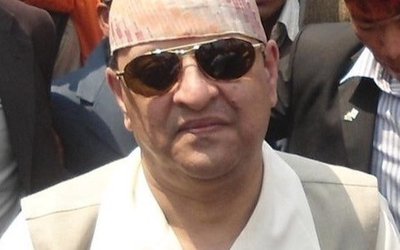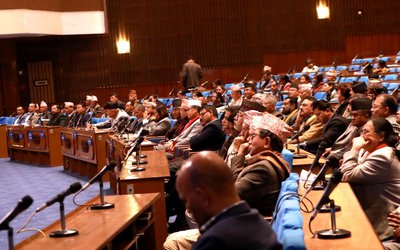
Despite the commitment of the government to reach assistance to the needy, Gyan Lal Maharjan, a resident of Sankhu, is yet to receive any such help. He has been surviving with the support coming from his own communities and volunteers from outside the village. Nepal Red Cross provided Maharjan with galvanized sheet to build his temporary shelter.
Maharjan is not alone in facing this kind of situation. Many other residents of Sankhapur have similar stories to tell. With the galvanized sheet provided by NGOs and food by other INGOs, people have survived the vagaries of monsoon.
Almost four months have passed since the earthquake of April 25, which turned the old city of Sankhu into rubbles. People here are gradually returning to normalcy. Had the rubbles of the old house been cleared earlier and soft loan provided to the victims, the city would have started reconstruction earlier.
As the government is heavily involved in the political issues back in Kathmandu, without even appointing the executive officer of National Reconstruction Authority for over a month, it is the community and volunteers who have work edtogether to end the suffering of people.
Although the government appointed Dr.Govinda Raj Pokharel as the CEO of the Authority, he is yet to perform his responsibilities fully. Only that, the appointment has opened the doors for reconstruction.
Although the government is busy in the constitution making process, volunteers have showed no sign of weariness. “When the earthquake hit Nepal on 25 April, the first responders were community members themselves: neighbors, family members and friends grouping around to help one another. When rescuers and aid workers started to arrive to help, many community members joined the relief effort, most as unpaid volunteers,” said UNIC’s press release.
The volunteers remain at the forefront of the response. Their roles have shifted from assessing needs, delivering food and other life-saving supplies, to helping build temporary shelters and other activities. These volunteers have shown commitment, dedication and persistence, many of them putting their own lives and jobs on hold to help the affected, even when their own houses were destroyed.
Jamie McGoldrick, the Humanitarian Coordinator in Nepal, was once a UN volunteer himself. He recently told a group of volunteers: “As a former UN volunteer, I can say this is a once in a lifetime opportunity for you to use your skill to help your community and your country.”
To this day, volunteers are continuing to serve the broader community, even though they themselves have experienced intense losses in the earthquake. From doctors to engineers and people from other professions, the volunteers have contributed greatly to bring the change in the lives of the affected people.
UNHAS
Even as the earthquake devastated areas demand quick transport to ferry things, United Nations Humanitarian Air Service (UNHAS) is facing critical shortfalls of funds.
According to United Nations, without essential and urgent funding for its services, UNHAS flights can only operate until mid-August. UNHAS, the WFP-managed UN humanitarian air service, continues to provide the entire humanitarian community in Nepal with access to hard-to-reach locations, delivering humanitarian supplies needed for life-saving projects.
Based on demand for the use of UNHAS services by the humanitarian community, the UN Resident and Humanitarian Coordinator has issued an appeal to donors for immediate assistance of US$9 million, otherwise at least 146,000 will be left without access to shelter, food and other humanitarian items
Moving into the third and final phase of the earthquake response will begin in mid-August and continue through to the end of December 2015, WFP is intensifying early recovery and rehabilitation activities.
WFP will be focusing on a reduced number of earthquake-affected districts than in previous phases, concentrating in areas with severe and high levels of food insecurity. Levels of food insecurity were already assessed post-earthquake and ongoing planning is being informed by fresh data currently being gathered.
Infrastructure Working Group
Much still needs to be done to repair damaged infrastructure as a result of the earthquakes. WFP has proposed the establishment of an Access Infrastructure Working Group, which has been endorsed by the Humanitarian Country Team. This will provide a forum for the Government of Nepal, donors, UN and NGO partners working in this sector. The group will aid in coordinating and planning activities more efficiently, ensuring that available resources are used in the most effective way possible, reviewing immediate needs and investigating where assistance can be provided.
In numbers, 2 million people were reached in the immediate relief in the first phase of the emergency operation.
Over 908,300 people (83% of WFP’s objective to reach in phase II) have received assistance in the structured relief second phase, of which over 93,300 people have been reached through the cash for assets program.
According to WFP, Nepal Earthquake 2015 Flash Appeal called for US$422 million (50.6% funded) Emergency Operation: US$80.3 million (43% funded), Special Operation Logistics Augmentation and Emergency Telecommunications: US$32.9 million (36% funded) Special Operation UNHAS: US$13 million (68% funded, budget revision underway)
“Achieving as much as we have to date would have been impossible without the leadership of the Government and the commitment of the people and communities of Nepal themselves,” said Jamie McGoldrick, Humanitarian Coordinator in Nepal. “I am truly heartened by the outpour of solidarity and compassion we have witnessed; proving that humanity can transcend social and economic barriers.”
To date, more than 340,000 families who lost their homes were provided with emergency shelter and another 170,000 households received materials to improve their damaged dwellings. Food assistance was delivered to over 2 million people and some 2 million people continue to benefit from sustained water and sanitation support. Basic medical services were re-established in 99.8 per cent of the community healthcare centers.
Yet, the needs remain significant. Hundreds of thousands of survivors still require basic shelter, food and livelihoods support, water and sanitation, and protection. “Providing assistance to the survivors is our collective responsibility,” said McGoldrick.
“The many pre-existing vulnerabilities which were exacerbated by the quakes will not go away on their own. Addressing the existing humanitarian needs and providing an enabling environment for communities to lead the recovery and reconstruction efforts is key to preventing any future loss of life.” To date, the international community provided some US$ 225 million (or 53 per cent) in support of the $422-million humanitarian appeal. An additional $227 million was received in the form of bilateral and in-kind support.
Despite completing some of the works, there is the need to take many steps to meet the requirements of earthquake victims. Only through the strong collaboration between the government, UN Agencies, INGOs, NGOs, communities and volunteers, the situation can be changed.
- IME GROUP: Expands Into Paper Industry
- Mar 24, 2025
- CPN UML: Instigated By India
- Mar 23, 2025
- ADB’S CHIEF ECONOMIST: Nepal Reduces Poverty
- Mar 11, 2025
- FM DR. DEUBA: A Successful Visit
- Mar 11, 2025
- MD GHISING: Target Of Personal Grudge
- Mar 09, 2025















